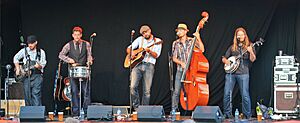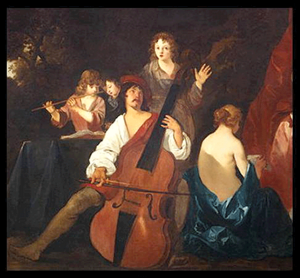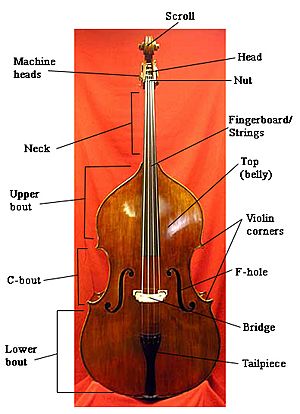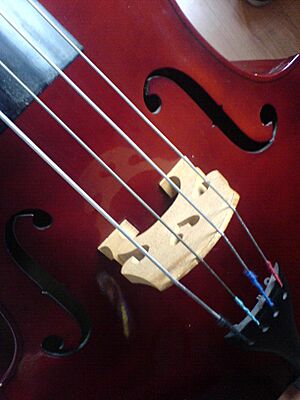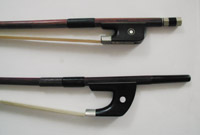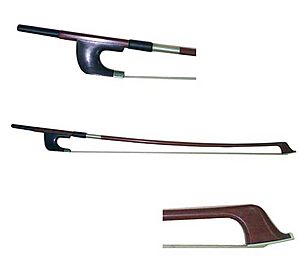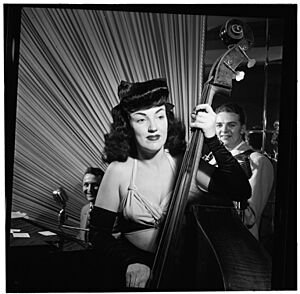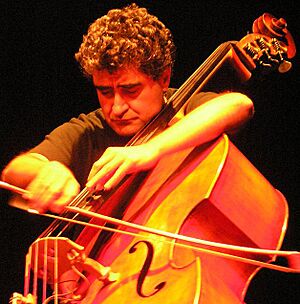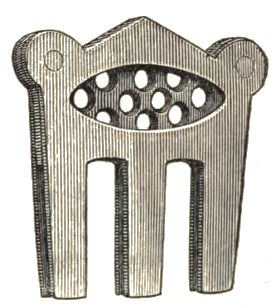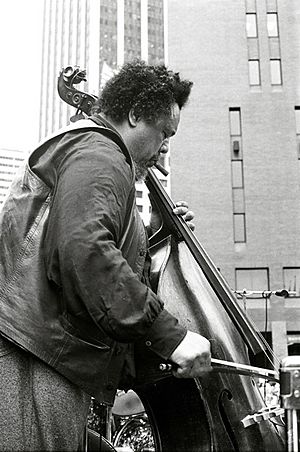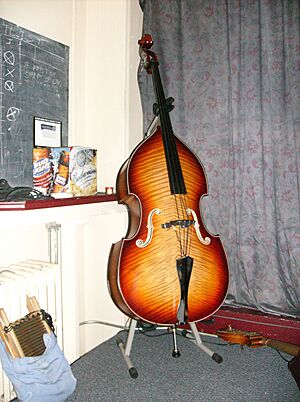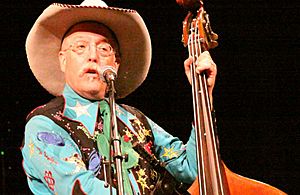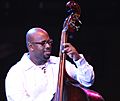Double bass facts for kids
The double bass is a very large string instrument. You might also hear it called a contrabass or upright bass. It's used in many types of music, like orchestras, jazz bands, rockabilly, bluegrass, and some country music. This instrument plays the lowest notes in a band or group. In jazz, these low notes are called the "bass line." The double bass looks a bit like a giant violin, viola, or cello.
Contents
What does a double bass look like?
A double bass is usually about 180 cm (6 ft) tall from top to bottom. But there are smaller sizes, like 1/2 or 3/4, for players of different heights. These smaller sizes are not actually half or three-quarters the size of a full bass; they are just a bit smaller.
The instrument is usually made from different kinds of wood. The back and sides are often maple, the top is spruce, and the fingerboard (where you press the strings) is ebony. It's not totally clear if the double bass came from the viol family or the violin family. But it shares features with both!
How do you play the double bass?
Like other string instruments, the double bass can be played in two main ways:
- With a bow (this is called arco).
- By plucking the strings (this is called pizzicato).
In orchestra music and tango, players use both bowing and plucking. In jazz, blues, and rockabilly, plucking is most common. But sometimes, players will use the bow for solos or special parts.
When playing classical music, bassists focus a lot on using the bow. Low notes played with a bow can sound dark and powerful. But if played softly, they can sound smooth and gentle. Classical bass students learn many bowing styles, like `détaché` (separate notes) and `legato` (smooth notes). They also learn `vibrato`, which is a wobbly sound made by rocking the finger on the string. This adds feeling to the music.
In jazz and rockabilly, players mostly pluck the strings. Jazz bassists often play very fast plucking lines called "walking bass lines." They also develop quick plucking skills for solos. Sometimes, they add "ghost notes," which are quiet, percussive sounds, to make the rhythm more interesting.
Double bass players either stand up or sit on a tall stool. They lean the instrument against their body. The top part of the bass is sloped, which makes it easier to reach the strings when playing higher notes.
History of the double bass
The double bass is thought to be a modern version of string instruments from the 1400s in Europe. Many old double basses only had three strings, unlike the four strings of violins or cellos. The double bass is also deeper (front to back) than violins. Its sloped shoulders are like the viol family, making it easier to play.
The double bass is the only modern bowed string instrument tuned in fourths (like a viol), not fifths (like a violin). There's still some debate about its exact family tree. Some experts say it's truly part of the violin family, while others say it's a mix of both viol and violin.
How is the double bass designed?
The double bass usually comes in two main shapes: the violin shape and the viol da gamba shape. There's also a less common "busetto" shape. The back of the instrument can be rounded, like a violin, or flat and angled, like a viol.
The double bass has many parts similar to violins. It has a wooden bridge to hold the strings, two f-holes (sound holes), and a tailpiece where the strings attach. It also has a scroll at the top and a sound post inside. The sound post helps send vibrations through the instrument.
Unlike other violin family instruments, the double bass usually has sloped shoulders and an angled back. This makes it easier to play higher notes. It also uses metal tuners instead of wooden pegs, which makes tuning easier.
How is it built?
The double bass is built much like a violin, but it also shares features with the violone (a large viol). Unlike the violone, the double bass fingerboard has no frets. High-quality basses have ebony fingerboards. Less expensive ones might use other woods painted black. The fingerboard is curved, just like the bridge, so players can bow each string separately.
A big difference from other violin family instruments is the tuning system. Violins, violas, and cellos use friction pegs. The double bass uses metal machine heads with gears. Turning a key on the machine head tightens or loosens the string, changing its pitch. At the bottom of the bass is a metal rod called an endpin, which rests on the floor. It's thicker than a cello's endpin because the bass is heavier.
Professional basses are often made of maple (for the back, neck, and sides) and spruce (for the top). The fingerboard is ebony. Less expensive basses might use laminated wood (plywood). Plywood basses are stronger and less likely to crack from changes in heat or humidity. This makes them popular in schools or for touring musicians. Hybrid basses have a laminated back but a carved wood top.
Inside the bass are the soundpost and bass bar. These parts are glued in place, except for the soundpost, bridge, and tailpiece, which are held by string tension. If the soundpost falls, a special repair person called a luthier is needed to fix it. The bridge is carved to fit each instrument. Professional bassists often have adjustable bridges, which let them change the string height.
Famous double bass makers come from all over the world, especially Italy. These old, handmade instruments can be very expensive.
What about the strings?
The way double basses are played has changed a lot because of how strings developed. In the past, strings were made from animal gut. But these strings were very thick for low notes, making them hard to play. Then, around the 1650s, "overwound" gut strings were invented. These had a thin wire wrapped around a gut core, allowing for lower notes with thinner strings.
Today, most double bass strings are made of steel. Steel strings stay in tune better and are louder when bowed. They are also stronger and less affected by weather than gut strings.
Gut strings are still used by players in older music styles like baroque, rockabilly, and traditional blues or bluegrass. They give a darker, "thumpy" sound. Rockabilly and bluegrass bassists also like gut strings for "slapping" (hitting the strings against the fingerboard), because it's easier on the fingers. Nylon strings are a cheaper option, with wire wrapped around them for lower notes.
Steel strings allow players to set the strings closer to the fingerboard. This means players can play higher notes on the lower strings and still get a clear sound.
What kinds of bows are there?
The double bass has two main types of bows:
- The "French" bow, which looks like bows for violins and cellos.
- The "German" bow, which is shorter and held differently.
These bows offer different ways to move your arm and put weight on the strings. Some players prefer the French bow because it's easy to move. Others like the German bow because it lets them use more arm weight. Both are used by professional players today.
German bow
The German bow is the older design. It comes from the viol family. Players hold it with their palm facing upwards, like shaking hands. The thumb helps create the sound.
French bow
The French bow became popular in the 1800s. It's held with the hand resting by the side, palm facing the bass. The thumb rests on the bow stick. The way you curve your fingers can change depending on the music.
How are bows made?
Double bass bows are usually 60 to 75 cm (24 to 30 inches) long. They are shorter and heavier than cello bows. Good quality bows are made from Pernambuco wood, but other materials like fiberglass or carbon fiber are also used. The frog (the part you hold) is usually made of ebony.
Bows have horsehair, usually white or black, or a mix of both. Some bassists think black hair "grabs" the thicker strings better. The hair needs to be replaced regularly by a luthier.
What is rosin?
Players rub rosin on the bow hair. This sticky stuff helps the hair grip the strings and make them vibrate. Double bass rosin is usually softer and stickier than violin rosin. Players choose different types based on the weather and their personal preference.
How is the double bass tuned?
The double bass is usually tuned in fourths. This is different from violins, which are tuned in fifths. The standard tuning for a four-string bass, from lowest to highest, is E–A–D–G. This is the same as a bass guitar, but one octave lower than the four lowest strings of a regular guitar.
Sometimes, music needs notes lower than the E string. There are a few ways to play these notes:
- Players can tune the low E string down to D or C.
- Some basses have a "low-C extension," which is a special device that lets the E string play lower notes.
- Some players use a five-string bass, with an extra low string tuned to C or B. Many big European orchestras use five-string basses.
Playing and performing
How do bassists stand or sit?
Double bassists can either stand up or sit on a tall stool. The endpin (the rod at the bottom) is adjusted so the player can comfortably reach the strings. When playing in the instrument's highest range, players use a technique called thumb position. This is where they flatten their hand and use the side of their thumb to press down the string.
How loud is it?
Even though the double bass is big, it's not as loud as many other instruments because it plays very low notes. In a large orchestra, usually four to eight bassists play the same part together to make enough sound.
When a composer writes a solo for the double bass, they usually make sure the other instruments play softly so the bass can be heard. In jazz and blues, players use amplifiers and speakers to make the bass louder. A small microphone or pickup connects the bass to the amplifier.
Sometimes, in loud settings, the bass can create unwanted feedback (a loud squealing sound). To stop this, players might turn down their volume or use special electronic devices. Some bassists use an electric upright bass, which looks like a double bass but has little or no body, so it doesn't feed back.
In rockabilly, players often slap the strings against the fingerboard for a percussive sound. Since regular pickups don't pick up these sounds well, rockabilly bassists often use both a pickup and a small microphone.
How do you transport it?
The double bass is large and delicate, so it can be hard to move around. Most bassists use soft cases called gig bags to protect their instrument. These can be thin or thickly padded. Some cases have wheels or backpack straps.
For flying, bassists might use very strong hard cases made of carbon fiber or fiberglass. These cases are expensive, and airlines charge a lot to ship them.
What accessories are used?
Double bass players use different tools. Mutes are used in orchestras to make the sound quieter and darker. There are wooden mutes, rubber mutes, and heavy rubber practice mutes for quiet practice.
A quiver is a leather holder that attaches to the bass. It holds the bow when the player is plucking the strings.
A wolf tone eliminator is a small device that helps stop unwanted vibrations that can make certain notes sound bad.
To tune, bassists often use an electronic tuner. This device shows the pitch on a screen. Bassists who use amplifiers might use a "stompbox" tuner, which mutes the bass while they tune.
A double bass stand is used to hold the instrument when it's not being played.
Double bass in jazz
Around the 1890s, early jazz bands in New Orleans used a tuba or sousaphone for the bass line. But by the 1920s, the upright bass slowly took over. Many early bassists played both the tuba and the upright bass. Jazz bassists play "walking bass lines," which are improvised (made up on the spot) lines that follow the chords.
Because the upright bass was quiet, many players in the 1920s and 1930s used a "slap style." They would slap and pull the strings to make a rhythmic "slap" sound. This helped the bass be heard better, especially on early recordings.
Jazz bass players need to be able to make up their own accompaniment and solos. They also need to know different rhythmic patterns. If they play in a big band, they might need to read written music.
Many famous jazz bassists have helped shape the music. These include Jimmy Blanton, Oscar Pettiford, Paul Chambers, and Charles Mingus. Since the 1950s, jazz bassists have used amplifiers to make their instruments louder.
In the 1970s, the electric bass guitar started to be used more in jazz fusion music. But for most jazz styles, the upright bass is still the main bass instrument. The upright bass has a unique sound because its strings are not stopped by metal frets, and its sound comes from the wood body vibrating.
Double bass in bluegrass and country
The upright bass is the most common bass instrument in bluegrass music. It's almost always plucked, though some modern players use a bow. The bassist helps keep a steady beat. Many bluegrass bassists use the 3/4 size bass.
In early traditional music, the cello was sometimes used for bass. But then the upright bass became popular. Some modern bluegrass bands use electric bass because it's easier to carry. However, many musicians prefer the "earthy" sound of the upright bass, especially with gut strings.
Bluegrass bass lines are usually simple, often playing the root and fifth of each chord. But bassists might do a "walkup" or "walkdown" (playing notes up or down the scale) when chords change. If a bassist gets a solo, they might play a "walking bass line" with a note on every beat.
The upright bass was also the standard bass in traditional country western music. While it's still used sometimes, the electric bass has mostly replaced it in modern country music.
Slap-style bass
Slap-style bass is sometimes used in bluegrass. When players slap the string against the fingerboard, it makes a high-pitched "clack" or "slap" sound along with the low note. This adds a rhythmic element. Some bluegrass bassists use it for solos or to make certain parts of a song stand out.
Double bass in popular music
In the early 1950s, the upright bass was the main bass instrument in early rock and roll music. Bands like Bill Haley & His Comets used it. In the 1940s, rhythm and blues music also featured the upright bass.
But upright bass players in these loud bands faced problems. It was hard to hear the bass over loud horns and electric guitars. The upright bass also caused feedback (squealing sounds) when amplified in big venues. Plus, it was big and hard to transport for touring bands. Some early rock and roll bands even used the slap bass for percussion instead of a drummer.
In 1951, Leo Fender released the Precision Bass, the first successful electric bass guitar. The electric bass was easy to amplify, easy to carry, and easier to play in tune because it had metal frets. As bands played louder and in bigger places in the 1960s and 1970s, the electric bass became the main instrument for pop and rock music. The upright bass became less common in popular music.
Images for kids
-
Jazz bassist Ron Carter playing with his Quartet.
-
The Italian bass player Domenico Dragonetti helped composers write more challenging parts for the bass.
-
Serge Koussevitzky made the double bass popular as a solo instrument in modern times.
-
Christian McBride (born 1972), a famous jazz bassist who has won many awards.
-
Scott Owen, double bass player for the Australian rock band The Living End.
-
Jazz singer and bassist Esperanza Spalding performing at the Nobel Peace Prize Concert.
See also
 In Spanish: Contrabajo para niños
In Spanish: Contrabajo para niños




